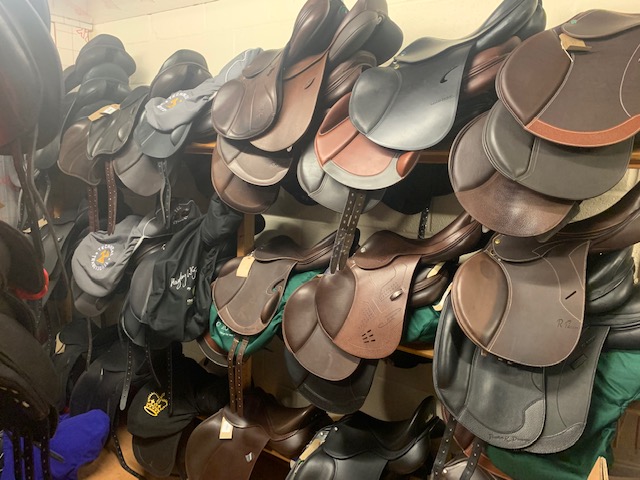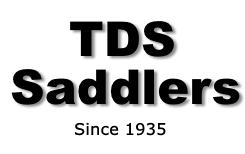Saddle Information
Guide to English Saddles
There are many different saddles which can be used for different disciplines in riding. It’s therefore important to understand the many parts of a saddle and what the various types are used for. This way you can find the right saddle for yourself, your horse, and the riding discipline you’ll be undertaking.

Our guide can help you to understand how a saddle functions and the type of saddle you might need for your riding.
Parts of a Saddle
The basic parts of the saddle will be the same for all riding disciplines, but they will be modified for each use.
Tree
The tree is the foundation of the saddle, made from wood, steel, or a synthetic material. The tree will determine the shape and appearance of the saddle. Some can be adjusted, covering narrow to extra wide fittings. Others may need adjustable gullet plates to change the saddle width.
Cantle
The cantle is at the rear of the saddle and provides support at the back.
Pommel
The pommel is at the front of the saddle. It curves upwards to support at the front and also protects the horse’s spine from the tree.
Seat
The seat is where the rider sits on the saddle. It will either be shallow, medium, medium-deep, or deep, depending on the riding discipline.
Twist
The twist sits in front of the seat and will affect how the saddle rests between the rider’s legs. Twists can be narrow, medium or wide, and will be decided on based on the rider’s preference and area of riding.
Panel
The panel is between the tree and the horse’s back. It will usually contain a flocking material, air cushioning, or synthetic material.
Knee Roll
The knee roll is a cushion to support for the rider’s knees, towards the front of the saddle.
Saddle Flap
The saddle flap hangs down from the seat and will not have contact with the horse’s back. Its length and shape will be different depending on the rider and riding discipline.
Stirrups
The stirrups are held by metal stirrup bars attached to the tree. The rider’s feet will rest in the stirrups. They are usually adjustable so the right length can be found for the rider’s comfort and the riding discipline.
Types of Saddle
There are different types of saddle which can be used for various riding disciplines. Below are some of the common types of saddle.
General Purpose Saddle
A general purpose saddle, also known as a GP saddle or all purpose saddle, is the most commonly used saddle. They are designed to be suitable for multiple disciplines, including flat riding and jumping. The seat will be deeper, with a more forward flap. There will be some padding to provide comfort when jumping.
Jump Saddle
A jumping saddle, sometimes known as a close contact saddle, is used for show jumping, hunt seat equitation, and the show jumping and cross-country stages of eventing. It has a forward-cut flap that accommodates a shorter stirrup length. The flap will also usually have thickly padded knee rolls. The cantle and pommel will be relatively low, so they do not affect the rider’s position for jumping. The seat will be set further back.
Dressage Saddle
Dressage saddles will have a straight-cut flap which will be longer than jumping saddles. This is to allow for the leg position of the rider, which will be longer for a dressage rider. The pommel will be higher and the seat will be deeper and set further forward. There is minimal stuffing of the saddle panels, so the rider has a closer feel with the horse to better give aids.
Endurance Saddle
The endurance saddle is used for long-distance endurance riding. The design was originally based on the military or police saddles. The seat will usually be more padded and the stirrups will be wider, to give more comfort to the rider over long periods of time. The panels are larger to cover a wider area of the horse’s back, to reduce fatigue.
Saddle FAQs
What size saddle do I need?
It’s best to get your saddle fitted by a professional, to ensure it is correct for both your horse and yourself. TDS Saddlers provide a professional saddle fitting service and can give you advice and support for picking the right saddle.
Do you buy a saddle to fit the horse or rider?
The saddle will need to fit both the horse and the rider. If the saddle is the wrong size for the rider, it will cause discomfort and make riding difficult. If the saddle is the wrong size for the horse, it can cause training and health issues.
Where should a saddle sit on a horse?
The saddle should fit comfortable on the horse’s back. It should be away from the horse’s shoulder blades so they can move freely and not touching their spinal processes. Our saddle fitting guide can help you toe ensure the saddle is sitting correctly.
What is the most comfortable horse saddle?
How comfortable your saddle is will depend on how well it fits and what discipline you will be using it for. We have a variety of saddles available. If you’re not sure what saddle is suitable for you, please contact us on tom@tds-saddlers.com, or call us on 01420 562758 to discuss what you need.
What is the best saddle for jumping?
If you will be jumping, you will need a jump saddle. We have a large range available, from top brands who produce the world’s best jumping saddles, manufactured to a high standard with quality materials.
How do I know if my saddle fits?
You know the saddle is fitting because you will be able to comfortable hold your position whilst riding. Also, you horse will ride well and not show any signs of distress or pain. Our saddle fitting guide can help you to fix any problems with the fit of your saddle, including if your saddle keeps slipping sideways.
